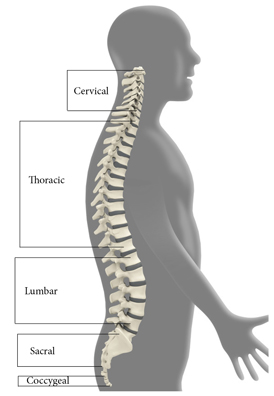Spinal Cord Anatomy and Function
The spinal cord is a bundle of nerve fibers that lead from the the brain stem. As protection, it is encased in the bony structure that is the spinal column, although the spinal column is, itself, longer than the spinal cord. The spinal column consists of a set of stacked bones called “vertebrae.” While the bones of the vertebrae are essentially contiguous to each other, there are spaces between them. The spaces are mostly filled with soft cartilage discs which act as cushioning such that the vertebrae do not rub against each other. In the spaces between the discs are small passages through which the nerves of the spinal cord pass and extend to other parts of the body.

The vertebrae comprising the spinal column are categorized and named according to their location along the length of the spinal cord starting from top to bottom. They are:
- Cervical vertebrae (1–7): neck;
- Thoracic vertebrae (1–12): upper back;
- Lumbar vertebrae (1–5): low back;
- Sacral vertebrae (1–5): hip area;
- Coccygeal vertebrae (1–4): fused together and constitute what is often called the “tail bone.”
Since the spinal cord is soft and serves as the pathway for signals to and from the brain, it does not provide physical support to enable the body to remain upright; that is the function of the spinal column — the bony structure of the vertebrae.
The spinal cord is protected by three layers of tissue, collectively called spinal meninges that surround the spinal canal and protect it from most traumas. The dura mater is the outside layer. Between it and the vertebrae is the epidural space filled with adipose (fat-like) tissue within which is a network of blood vessels. Next, is the arachnoid matter which is the middle protective layer and which has a spiderweb-like appearance, hence its name. The pia mater is the layer of tissue closest to the spinal cord. The area between it and the arachnoid is the subarachnoid space that contains cerebrospinal fluid (CSF).
In the bigger picture, the brain and the spinal cord constitute the central nervous system. It is in that respect that the nerves passing through the small spaces between the discs become extremely important. The nerves branch off to the right and left sides of the body. This nerve system is known as the peripheral nervous system and controls three primary bodily functions:
- Motor: the voluntary movements of the body, such as leg movements necessary for walking;
- Sensory: the perceptions of sensation, such as of pain or pressure; and
- Autonomic: involuntary functions that include blood pressure, digestion and others of which an individual is not consciously aware, at least until a Spinal Cord Injury occurs that interferes with its normal and intended function.
Spinal Cord Injuries (SCI) can be caused by a variety of occurrences including, but definitely not limited to, motor vehicle accidents, work-related accidents and sports injuries. SCI is a catastrophic injury that demands immediate, acute medical intervention. Once the individual has become medically stabilized, a range of spinal cord post-acute rehabilitation and specialized rehabilitation will be needed. The modalities of therapy, rehabilitation and special rehabilitation must be administered and supervised by a multidisciplinary team to help the individual regain independence to a degree consistent with his or her physical and mental health.
Regardless of the cause or type of SCI, when an individual becomes a Client of NeuLife Rehab in Mount Dora, Florida, he or she undergoes a comprehensive assessment with a Client Goal Plan meeting established for review by the Client, family members, nurse case manager and other appropriate parties, at an initial Client Goal Plan Conference scheduled less than one week following admission. Each Client Goal Plan includes clinical needs for rehabilitation and covers personal goals and preferences of the Client. Therapies are provided by NeuLife full-time staff members who are Florida licensed and/or certified professionals. The professionals include but are not limited to:
- Board Certified Neurologist
- Board Certified Behavior Analyst
- Board Certified Physiatrist
- Neuropsychologist
- Psychologist
- Board Certified Psychiatrist
- Speech-Language Pathologist/Cognitive Therapist
- Physical Therapist
- Occupational Therapist
- Nurses
- Certified Rehab Counselor
They, and all other members of the NeuLife Rehab multidisciplinary team are devoted to their calling to helping individuals with catastrophic injuries in this highly specialized program. This is fully in keeping with NeuLife’s dedication to consistently provide the highest standard of care in the delivery of clinically relevant services. NeuLife Rehab strives to achieve successful, sustained outcomes and exceed the expectations of all persons served.
Proper and timely post-acute rehabilitation that may determine the difference between disability and independence is what NeuLife refers to as the “platinum post-acute period” — the crucial window following acute care that is needed to nurture the whole person to health with specialized, clinically relevant services.
NeuLife’s philosophy is that healing, wellness and personal fulfillment are best achieved in a positive and uplifting therapeutic environment where caring staff encourages, assists and supports each client so he or she may achieve specific goals. NeuLife believes personal fulfillment is equally as important as goals to achieve function and independence.
NeuLife, in Mount Dora, Florida, is an accessible residential post-acute program providing specialized rehabilitation to individuals diagnosed with Traumatic Brain Injury (TBI), Spinal Cord Injury (SCI), Amputations, Burns and other Catastrophic Injuries and Challenging Diagnoses.
2725 Robie Avenue
Mount Dora, Florida 32757








